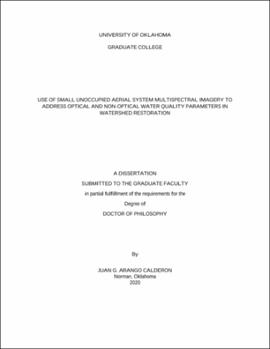| dc.description.abstract | Remote sensing is defined as the art, science, and technology of obtaining reliable information about physical objects and the environment through the process of recording, measuring, and interpreting imagery and digital representations of energy patterns derived from non-contact sensor systems. Currently, one of the many applications for this technology is to monitor and predict water quality. In recent decades, the use of remote sensing tools for estimation of Secchi disk depth (SDD), total suspended solids (TSS), chlorophyll-a (Chl-a), and colored dissolved organic matter (CDOM) in inland and near-coastal bodies of waters has proven not only to be accurate and reliable, but also has given the possibility to expand the discrete sampling point coverage associated with traditional in-situ sampling. In recent years, the emergence of compact multispectral sensors and small Unoccupied Aerial Systems (sUAS) has opened possibilities of collecting higher resolution multispectral imagery with study specific revisiting periods and minimal impact from atmospheric effects (e.g., cloud cover) at substantially lower costs.
The main purpose of this dissertation was to use multispectral imagery captured with the help of an sUAS to create/develop finer and more accurate models to predict both optical and non-optical water quality parameters capable not only to monitor small bodies of water, but also sizeable lakes with multiple beneficial uses and diverse land use and land cover within their watersheds. For that purpose, four studies were designed that not only evaluate the capabilities of sUAS in monitoring and predicting water quality in small and sizable water bodies, but also to incorporate this technology into a holistic long-term project that focuses on improving water quality at the watershed scale.
Results indicate that: (1) with the use of imagery captured by an sUAS, and a thorough understanding of the existing relationships between water quality components in the systems involved, optical and non-optical water quality parameters can be reliably estimated, (2) when using a multiple linear regression approach, models capable of predicting optical and non-optical models (with strong prediction capability R2 ≥ 0.80) can be created, (3) multiple variable linear regression models in the visible portion of the electromagnetic spectrum best describe the relationship between TSS (R2 = 0.99, p-value ≤ 0.01, n=15), SDD (R2 = 0.88, p-value ≤ 0.01, n=15), Chl-a (R2 = 0.85, p-value ≤ 0.01, n=15), Total Phosphorous (R2 = 0.98, p-value ≤0.01, n=15) and Total Nitrogen (R2 = 0.98, p-value ≤ 0.01, n=15), (4) although sUAS imagery increased the regression coefficients for the different evaluated models for this study compared to traditional remote sensing tools (e.g., Landsat 8 and Sentinel-2), the major limitations experienced when operating an sUAS are caused by flight restrictions, safety (improper piloting/ high wind speeds/ unclear airspace designations), battery life (20 minutes, which in turn decreases the size of the scene), and on-board sensor accuracy (large bandwidths and limited GPS precision), (5) 100% cloud free imagery can be collected with the use of sUAS, (6) the use of sUAS for water quality monitoring allows the user more flexibility in terms of temporal and spatial resolution, (7) current sUAS pre-processing tools are not capable of properly stitching images captured over large bodies of water, (8) generation of complete geolocated and radiometrically corrected true reflectance surfaces for large bodies of waters, allows for the estimation of optical water quality parameters using linear approaches, and (9) the use of sUAS in watershed monitoring programs has the potential to collect and provide information that can be used to enhance decision making and data collection. | en_US |
